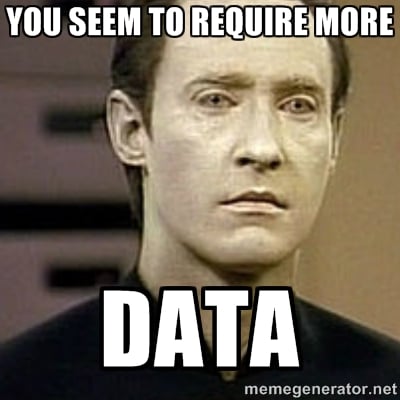You have /5 articles left.
Sign up for a free account or log in.
Data can do amazing things. It can predict which candidate is most likely to win the presidential election, or which team should win the world series. Data can even tell when (and why) a show like House of Cards will be a hit. Data is power, so the saying goes.
It predicts, verifies, supports and challenges in ways that even the most refined, intelligent opinions cannot. But realizing those benefits requires knowing what data to collect and what to do with it once it’s in-hand. That’s the challenge in higher education, specifically in the realm of digital marketing.
There’s growing awareness among higher education leaders and practitioners that digital promises an endless supply of metrics. Paired with the ever-present demand to demonstrate return on investment for every marketing activity with a digital component (hint: every marketing activity should have a digital component), higher ed marketers find themselves scrambling to answer some interesting requests around metrics.
“Can you tell me what site [insert specific individual, most likely a government person or major donor] looked at on his phone during that event?”
“How many applications did we get from that ad in the Chronicle?”
“Why aren’t people visiting this page we made but haven’t yet linked or promoted?”
…and the list goes on.
While there are ways to use digital metrics and analysis to inform answers to many of these inquiries, often the answers will remain uncertain at best. At worse, even the most accurate answer is still, well, pointless. So what’s a marketer to do?

Start With Goals. Measure with Purpose
Like outcomes, analytics should never be an afterthought. Even before you add tracking code, identify the strategic purpose and desired outcomes of a digital initiative, page, site or campaign, and consider what metrics will indicate progress toward those goals. If the goal is a little nebulous, like “raise awareness” or “increase engagement” then build a measurement plan that includes indicators of those outcomes — new sessions, content shares, time on page, scroll depth, site referrals, inbound links, search volume, social conversations, event registrations — there are plenty of metrics that can be used to demonstrate progress. For more specific goals, metrics can be more direct like form conversions, registrations, complete applications or requests for information. In every situation, you have to know where you’re going before you decide if you’re getting any closer.
Think Beyond Vanity and Volume
Long ago in the early days of digital metrics, success was often only measured in volume — how many hits, views, fans, likes and so forth. And those things were (and in some cases still are) indicators of success, particularly with regard to scope and scale of digital efforts. But bigger isn’t always better. Knowing ‘how many’ in the absence of any additional context reveals nothing about sentiment, quality of an experience, or whether or not it’s the right kind of traffic. With digital advertising for example, attracting huge numbers to a disappointing outcome does more harm than good and costs a lot more. The temptation always exists to try to optimize for bigger overall numbers because it makes you (and your bosses) look and feel good, but there’s more value in working toward strategic goals, whatever the scale. If bigger numbers move you closer to your goal, go for it. If it’s better numbers you’re after, think beyond size.
Explore Multiple Dimensions
Context is everything in digital measurement. A single metric — no matter how impressive — doesn’t give you the full picture. One of the more useful basic features in Google Analytics is the ability to add a secondary dimension to your report. Use secondary dimensions to look at which news stories were the most read during the past six months AND brought in traffic from reputable online outlets, were accessed via mobile device, or came from social channels, or international traffic, or traffic from your local community. Find which entry point on your website most often gets visitors to your key transaction pages. Which search terms have the highest volume but lowest retention? Setting up goals and conversion tracking can add even more to the data. Layering dimensions helps clarify the picture and unlocks the power of data as more than an evaluation tool — knowing what factors contribute to successful content, digital initiatives and strategies can reshape future efforts and in many cases, guarantee success.
**For the adventurous, get crazy with up to seven dimensions with Google’s Query Explorer.
Analog Support
There’s no question digital metrics can tell you more than you might want to know, but there are still plenty of elements in the analog world that influence digital outcomes. A strategically crafted, beautiful, optimized landing page with a powerful call to action that delivers inquiries or requests for information to a non-existent recruiting team won’t hit desired business outcomes. A social push to drive attendance for a poorly conceived, poorly timed event won’t work. Digital and analog elements must work together through every phase of a strategic initiative. That’s why you must start with goals (see above).
Influence
Data has power. A lot of power. As marketers, it’s our job to be responsible with that power, and honest about our data. In order to use data to defend, improve and empower, you also have to acknowledge what you didn’t, can’t or don’t know how to measure. Try not to selectively interpret just to prove that point. Use data for good. Use metrics to get better and improve results.
In the words of Sir Arthur Conan Doyle’s Sherlock Holmes ‘It is a capital mistake to theorize before one has data. Insensibly one begins to twist facts to suit theories, instead of theories to suit facts.’
Tim Jones is associate vice president of marketing at Clarkson University, in New York.








